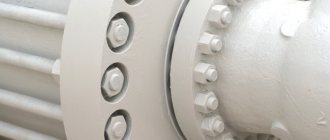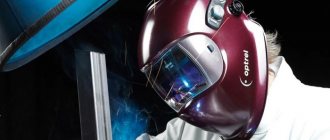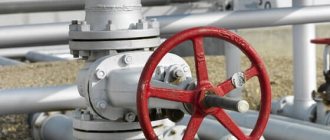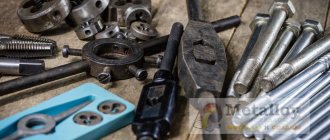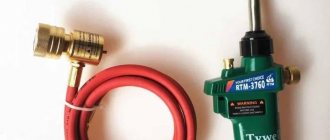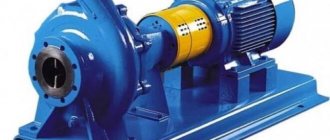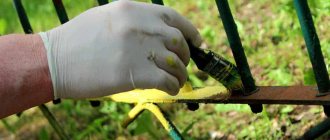Flanges are steel disks (rings) of various configurations; they are designed for quick-release connections on pipelines. They are attached by welding to pipe sections. They are necessary for installing shut-off valves, metering devices, and when installing new bends. They are put on the edge of the pipe. The most effective way to attach a flange to a pipe is welding. The rings must be fixed without distortions, strictly along the cross-section of the pipe.
Welding of flanges is carried out in several ways; each technology has its own nuances that must be taken into account to obtain a high-quality sealed seam that does not impede the flow of the transported liquid.
Regulations
For all of the above cases, clauses 3.2.14, 3.2.15 and 3.2.16 of the Rules for the Construction and Safe Operation of Process Pipelines (PB 03-108-96) are applicable. They say the following:
Design and work must be carried out in such a way that in the future it is possible to control the weld and, if necessary, carry out heat treatment. If the project uses pipes with a metal thickness of less than 8 mm, then at least 50 mm should be retreated from one weld to another, if more than 8 mm - 100 mm. In all other cases, there must be a distance between welds that is three times the nominal thickness of the material.
If the project has supports, then if the pipe wall thickness is up to 50 mm, 50 mm should be removed from them, and more than 50 mm - 200 mm.
To make a weld, a distance of 50 mm should be taken from the beginning of the elbow bend - this is for pipelines with an outer pipe diameter of up to 100 mm and at least 100 mm - for outer pipe diameters of more than 100 mm.
Each specific case is considered individually if it is impossible to maintain the distances specified in the first two paragraphs. The issue is resolved by the designer or a specialized research organization, taking into account technological parameters.
There is also PB 10-573-03 (for steam and hot water pipelines). Here we are interested in paragraphs 2.3.8 and 2.3. They allow welding joints of steeply curved bends at the beginning of the rounding. They can be welded directly, without additional straight sections.
Summarizing the above, it turns out that if certain conditions are met, it is possible to weld a flange to an outlet without a coil. It is worth considering some technical points.
Welding flanges to steel pipelines with a diameter of 100 mm
LOCAL RESOURCE STATEMENT GESN 22-03-014-03
| Name | Unit |
| Welding flanges to steel pipelines with a diameter of 100 mm | 1 flange |
| Scope of work | |
| 01. Attaching flanges to the ends of pipes. 02. Welding flanges. |
The price takes into account the work requirements for 2000
(Moscow prices), calculated according to the GESN model of
2009
. Indexation of translation into current prices must be applied to the cost.
You can go to the pricing page, which is calculated based on the standards of the 2014 edition with additions 1 To determine the composition and consumption of materials, machines and labor costs, GESN-2001 was used
| № | Name | Unit Change | Labor costs |
| 1 | Labor costs of construction workers Level 5 | person-hour | 0,7 |
| 2 | Labor costs for drivers (for reference, included in the price of the EV) | person-hour | 0,39 |
| Total labor costs for workers | person-hour | 0,7 | |
| Workers' compensation = 0.7 x 11.08 | Rub. | 7,76 | |
| Payroll for drivers = 5.26 (for calculating invoices and profits) | Rub. | 5,26 |
OPERATION OF MACHINES AND MECHANISMS
| № | Cipher | Name | Unit Change | Consumption | Article number Rub. | Total RUB. |
| 1 | 150202 | Two-station welding units for manual welding on a tractor 79 kW (108 hp) | mach.-h | 0,39 | 133,97 | 52,25 |
| Total | Rub. | 52,25 |
| № | Cipher | Name | Unit Change | Consumption | Article number Rub. | Total RUB. |
| 1 | 101-1513 | Electrodes with a diameter of 4 mm E42 | T | 0,00029 | 10315 | 2,99 |
| 2 | 507-9508 | Flat steel flanges | PC. | 1 | 0,00 | |
| Total | Rub. | 2,99 |
TOTAL BY RESOURCES: 55.24 RUR.
TOTAL PRICE: 63.00 RUR.
Look at the cost of this standard at current prices open page
Compare the price value with the value of FER 22-03-014-03
To draw up an estimate, the price requires indexation of the transition to current prices. The price is based on the GESN-2001 standards, as amended in 2009.
in
2000
.
To determine intermediate and final price values, the DefSmeta
Technical recommendations
It is not recommended to weld a flat flange to an outlet without a coil, because the connection is made with a fillet weld - the result is a rigid structure that experiences complex loads. The tightness of the seam under certain conditions (for example, during thermal expansion when a hot medium is supplied) may be broken.
Collar (“with a skirt”) and free (with flange) flanges are welded with a simpler and more reliable butt weld - a connection that is resistant to tensile and compression loads is obtained.
When connecting a flange to an outlet or transition, it is necessary to provide for the possibility of free insertion/removal of bolts or studs when assembling/disassembling the flange.
Source
Product classification
The general structure of the part is a ring and a plate with holes along the edge. To ensure tightness between the elements, a rubber gasket is also installed in accordance with the purpose of the pipeline - acid-resistant, heat-resistant. The ring and plate are connected using fasteners - bolts with nuts or studs.
According to GOST, there are several different types of flanges. According to the drawings, their differences are clearly visible.
Types of flange welding
Accordingly, welding of parts to the pipeline is carried out somewhat differently.
External flange welding
Prices for products vary markedly. However, the cost is determined more by the size of the plates, rather than their design, and weight, of course. According to GOST, they are made of carbon, alloy or stainless steel, as well as malleable cast iron. Metal prices determine the cost of devices.
Welding a flange to a pipe according to GOST
The welding technology is basically the same, with the exception of fastening the pipes. However, it is necessary to take into account the complexity of the design - it is recommended to clarify the drawings and compliance with the fastening requirements.
Internal flange welding
In most cases, it is necessary to maintain a gap in the joint. If backlash is not needed, the boat welding technique is allowed. If the backlash should be large - more than 4-5 mm, the product is welded with fillet welds. All this, of course, affects prices.
The dimensions of the seam depend on the pipeline. The width of the internal seam is usually equal to the wall thickness, the height is from 0.5 to 1 cm, which is determined by the cross-section of the pipeline. The outer seam requires more metal deposition, so it is somewhat asymmetrical.
Welding is done from 2 sides: first from the outside, and then, to seal the seam, from the inside. This method is most suitable for flat flanged parts. Welding on one side is carried out if the product is butt welded, as in the case of a collar flange.
Not every device for welding flanges to pipes is suitable. The Lisitsyn and Bondarenko apparatus is usually recommended. When welding, the electrode remains stationary here, and the pipeline rotates.
The video discusses the welding process in more detail.
Last news
Is it possible to directly connect standard piping fittings, such as flanges and elbows, two reducers, a reducer and an elbow? — doubts about this arise among both technological circuit designers and engineers. Are there any technical difficulties with this? Is such a solution permissible under the operating rules? Let's try to figure it out.
Selecting a flange for a 160 mm HDPE bushing and a 150 mm valve.
Our task is to install an MZV 30ch39r cast iron valve with a diameter of 150 mm on a 160 mm HDPE pipe. The first thing you need to figure out is which flange the valve itself has. Let's look at the specification:
- n number of bolts - 8 pcs;
- d diameter of holes for bolts - 22 mm;
- D outer diameter of the flange - 280 mm;
- D1 distance/diameter between the center of two holes - 240 mm;
- DN internal diameter of flange and valve 150 mm.
It is intuitively clear that if we need a flange in accordance with GOST 12820, then we need to choose a 150 mm flange. However, here we need to remember that the flange is installed on a HDPE bushing, which means we need to understand the following: can we install a flange, whose internal diameter is approximately 155 mm according to GOST 12820, on a HDPE bushing with an outer diameter of 160 mm. It is already obvious that the outer diameter of the bushing is at least 160 mm, but if we look at the photo and diagram, we will see that the bushing has some thickening and for a 160 mm bushing this thickening leads to the fact that the real diameter is in the place where the flange will “hang” will be equal to 175 mm (look at the diagram H2 = 175 mm).
And the flange has 155 - 160 mm, that is, it will not be possible to hang a standard flange according to GOST 12820 on such a sleeve. Understanding all this, manufacturers in Russia began to grind such flanges to the required internal diameter, and a large number of workshops appeared that specialized in boring flanges. And therefore, the internal diameter of our flange for this unit will be equal to 178 mm. Thus, flanges for HDPE bushings are often called bored.
However, today, most manufacturers in Russia and China have adapted to these needs and produce copies of flanges in accordance with GOST 12820, which are fully consistent with conventional welded flanges, with the exception that the inner diameter of these flanges corresponds to the outer diameter of the bushings.
Regulations
For all of the above cases, clauses 3.2.14, 3.2.15 and 3.2.16 of the Rules for the Construction and Safe Operation of Process Pipelines (PB 03-108-96) are applicable. They say the following:
Design and work must be carried out in such a way that in the future it is possible to control the weld and, if necessary, carry out heat treatment. If the project uses pipes with a metal thickness of less than 8 mm, then at least 50 mm should be retreated from one weld to another, if more than 8 mm - 100 mm. In all other cases, there must be a distance between welds that is three times the nominal thickness of the material.
If the project has supports, then if the pipe wall thickness is up to 50 mm, 50 mm should be removed from them, and more than 50 mm - 200 mm.
To make a weld, a distance of 50 mm should be taken from the beginning of the elbow bend - this is for pipelines with an outer pipe diameter of up to 100 mm and at least 100 mm - for outer pipe diameters of more than 100 mm.
Each specific case is considered individually if it is impossible to maintain the distances specified in the first two paragraphs. The issue is resolved by the designer or a specialized research organization, taking into account technological parameters.
There is also PB 10-573-03 (for steam and hot water pipelines). Here we are interested in paragraphs 2.3.8 and 2.3. They allow welding joints of steeply curved bends at the beginning of the rounding. They can be welded directly, without additional straight sections.
Summarizing the above, it turns out that if certain conditions are met, it is possible to weld a flange to an outlet without a coil. It is worth considering some technical points.
Technical recommendations
It is not recommended to weld a flat flange to an outlet without a coil, because the connection is made with a fillet weld - the result is a rigid structure that experiences complex loads. The tightness of the seam under certain conditions (for example, during thermal expansion when a hot medium is supplied) may be broken.
Collar (“with a skirt”) and free (with flange) flanges are welded with a simpler and more reliable butt weld - a connection that is resistant to tensile and compression loads is obtained.
When connecting a flange to an outlet or transition, it is necessary to provide for the possibility of free insertion/removal of bolts or studs when assembling/disassembling the flange.
The need to weld a flange to a pipe arises in organizations involved in the construction, maintenance or servicing of pipelines. not only supplies rolled metal throughout Russia, but also carries out metal processing. Our specialists know everything about welding and methods of installing metal products, so they will be able to weld flanges in accordance with the current welding regulations.
Subtleties of the process
Technological features of the welding process depend on the type of flanges. Flat flanges are mounted only on straight sections of pipe - unlike collar models, they cannot be welded to bends. Differences in welding methods for flat and collar flanges are explained by different types of seam joints (butt or corner) and the nature of the structure being formed. Flat-flange connections are made with a fillet weld, forming a rigid structure, which, when high-temperature substances are supplied, can collapse due to the difference in the coefficients of thermal expansion. Collar flanges are welded with a butt weld that can withstand significant temperature fluctuations.
PC Ferrum Hand employs qualified welders, craftsmen, engineers and technologists. They are certified by NAKS (state body for welding control), confirmed by issued certificates. The work is carried out using certified welding equipment. If the customer needs to weld a flange according to all the rules, we will do it professionally, quickly, and at affordable prices.
Sale of rolled metal in St. Petersburg and Leningrad region
Source
What is the flange for?
Basically, flanges are intended for forming quick-release flange connections on pipes. Unlike welding, this design makes it possible to quickly connect or remove individual parts of the pipeline, for example, to check the condition of the pipe in individual sections, install taps, sensors, to drain water or to connect equipment (the same heat exchanger). The flanges are welded onto the ends of the pipes and connected to each other with bolts and studs complete with a counter flange. Gaskets made of rubber or other materials must be placed between them.
Flanges are used in various industries and utilities for the hermetically sealed connection of a certain section of the pipeline to various technological devices and devices for the purpose of supplying and discharging media, as well as for joining individual sections of the pipe to each other.
Classification. Flange types
Flanges in different countries are manufactured to standards that correspond to the specific regulations adopted in those countries. This can be GOST (for Ukraine DSTU ISO 7005-2:2005 (ISO 7005-2:1988, IDT). Metal flanges.)), DIN or TU. The shapes are divided into round and square. Two significant groups of flanges can be identified:
- for fittings
- for vessels and apparatus.
The following are the most commonly used types of flanges:
Welded flange collar, slip-on, socket, freely rotating, threaded, blind flange. Let's briefly go through each of them.
Collar flange
They have a characteristic welded neck in the form of a conical concentrator, smoothly transitioning to the pipe wall. It ensures distribution of the pressure of the supplied substances through the conical hub. Used for pipelines with high pressure or high/low temperatures. The collar flange must be welded using a V-shaped or continuous seam.
Flange pipe Most often used for secondary tasks as a flange backing for inexpensive flanging.
Socket flange
Designed for small-sized pipes with high pressure. Their service life is twice as long as that of welded slip-on flanges. Disadvantages include the possibility of ruptures and susceptibility to corrosion.
Welding of socket flanges is carried out only from the outside with a fillet butt weld, while it is necessary to leave a small gap of approximately 1.6 mm to compensate for the effect of thermal expansion (indicated “X” in the picture).
Slip-on flange
Requires smooth pipe edges when connecting. Their service life is two to three times less than that of collar flanges. due to Welding of cap flanges is carried out on the outer and inner sides using fillet welds. In order not to damage the flange surface during welding, it is necessary to have a gap of 3 mm between the end of the pipe and the inner edge of the flange.
Rotating flange
Rotates freely on the pipe, not welded. The rotating flange can be easily removed and replaced if necessary. Can be fastened with opposite bolt connections.
Flange connections of polypropylene (plastic) pipes
Flanges are steel disks (rings) of various configurations; they are designed for quick-release connections on pipelines. They are attached by welding to pipe sections. They are necessary for installing shut-off valves, metering devices, and when installing new bends. They are put on the edge of the pipe. The most effective way to attach a flange to a pipe is welding. The rings must be fixed without distortions, strictly along the cross-section of the pipe.
Welding of flanges is carried out in several ways; each technology has its own nuances that must be taken into account to obtain a high-quality sealed seam that does not impede the flow of the transported liquid.
Weld quality control
To check the tightness of the flange fastening, an ultrasonic method is used. The seam is checked:
- on cracks;
- the presence of slag inclusions, sagging, cuts;
- Burns, craters, and porosity are unacceptable.
Flaw detection is also carried out by metallography. At critical connections, the quality of welding of flanges to pipes is checked by radiographic non-destructive testing.
Knowing the intricacies of fixing the flanges, if necessary, you can independently weld the disk to a section of the plumbing system.
Product classification
The general structure of the part is a ring and a plate with holes along the edge. To ensure tightness between the elements, a rubber gasket is also installed in accordance with the purpose of the pipeline - acid-resistant, heat-resistant. The ring and plate are connected using fasteners - bolts with nuts or studs.
According to GOST, there are several different types of flanges. According to the drawings, their differences are clearly visible.
Types of flange welding
Accordingly, welding of parts to the pipeline is carried out somewhat differently.
Connections of polypropylene pipes with a metal component
When polypropylene systems are finite load bearing, precautions must be taken when connecting them to metal pipes or components made from other materials.
In such cases, a mechanical transition reinforced externally or tied/blocked with special mechanical stops may be required to prevent any load-bearing connections from moving away.
Large diameter polypropylene pipes are often characterized by a mismatch (in size and bolt holes) between the connection to the metal pipe. Structurally, the discrepancy is due to the fact that the polypropylene specimen has thicker walls.
Features of plastic-metal interfaces
When considering multi-component polypropylene piping systems, it is important to remember:
A polypropylene pipe is always characterized by dimensions according to the OD (Outer Diameter) standard, while metal products are characterized by a nominal diameter size according to the DN (Diameter Nominal) standard.
For example, a 450mm polypropylene OD Excel (PE100) SDR17 (400mm orifice) is connected to a 450mm PN16 valve using only a traditional 450x450mm flange adapter.
Flange connection with metal fittings: 1 - plastic-metal fastening with a transition of 450 mm to 450 mm; 2 — plastic-metal mount with a transition of 450 to 400 mm
But then it turns out that the size of the holes in the polypropylene pipe and valve at the transition varies from 400 mm (PE) to 450 mm (metal).
The flange connection solves this problem by providing a fully load-bearing fitting that fits most standard sizes and can withstand high tensile loads.
One example of such a flange connection is a product from the British company GPS, branded “SlimFlange”.
Unique thin flange for polypropylene
The unique flange adapter for polypropylene products supports the connection of PE pipes with diameter sizes of 250 - 560 mm. A flange fitting allows for an actual or similar diameter connection of a polypropylene pipe to the flange of a steel (metal) pipe of a similar size.
The “SlimFlange” technological transition adapter ensures reliable sealed coupling of pipeline components, including plastic-metal connections
The technical and mechanical advantage of the SlimFlange flange clip is achieved by installing a steel hoop on the edge surface of a polypropylene pipe to provide a reinforcing effect.
The flange hoop optimizes the polypropylene pipe in terms of shoulder height, creating an increased connection strength. Improved sealing performance is achieved, also when flanges are butted together.
Unlike traditional plastic flanges, thin polypropylene flanges (“SlimFlange”) eliminate the need to increase or decrease the size of the valve or other metal component being connected.
The flanged support ring allows free rotation, making it easy to bolt together valves or other parts in the connection area. There are also special flange adapters for plastic pipes with a diameter of more than 560 mm.
As for "SlimFlange" thin plastic flanges in general, the back-up rings have bolt holes that are sized slightly differently than the back-up rings found on conventional polypropylene piping flange clip adapters.
Recommendations for mechanical connections
For pipe sizes where "SlimFlange" flanges cannot be used due to size restrictions, a manufactured fitting with a reduced size PE flange is a possible alternative.
Combinations of connections depending on the characteristics of the transitions: 1 - 'combined' adapter 450x400 PN16; 2 - 'combined' adapter 600×500 PN16
However, larger sizes cause reduced strength. Therefore, this product is not suitable for gas installations.
Due to the reduced number of holes on this type of fitting, it is advisable to include a metal reinforcement plate between the polypropylene and metal flanges to stabilize the assembly.
Flange connections of plastic pipelines must be made with a single continuous surface or with the installation of a rubber gasket. For applications in critical conditions it should be additionally reinforced with a steel gasket.
All four mating surfaces of the flange connection must be undamaged and free of contamination.
Steel reinforced gaskets have the advantage of compliance without any risk of pressure extrusion.
Features of screed installation
For applications where significant temporary pressures are possible, the profiled steel reinforced gasket specification ensures the highest possible long-term safety.
If possible, flange connections should be made before other connections are made. If this is not possible, it is recommended to position the pipeline in such a way that the mating surfaces are aligned and tightly connected to each other.
The maximum permissible distance to bolts is 5 mm, regardless of the diameter of the pipeline.
Only use clean, undamaged nuts and bolts of the correct size. The threads on the bolts must be treated with a small amount of lubricant. The fastening bolts must be equipped with standard thick washers (form A) on both sides.
Ensure that the flange joint gasket is properly centered before tightening the bolts. Nuts and bolts should be tightened gradually and evenly using a torque wrench in a diagonally opposite sequence.
Recommended bolting sequences for flange connections (5%, 20%, 50%, 75%, 100% final torque) are shown below:
Bolt tightening torques: 1 - four bolts; 2 — six bolts; 3 - eight bolts; a - first quadrant; b - second quadrant
When working with polypropylene pipe diameters greater than 180 mm, it is recommended to use two fitters to simultaneously tighten diametrically opposed bolts, where possible.
Criteria for tightening bolts
To ensure the subsequent tightness of the flange connection, it is recommended to repeat the final tightening of the bolts after a pause of an hour or two.
Tightening uniformity across a flange connection is as important as the final torque values. The table below shows the torques for polypropylene flange connections of the SDR11 and SDR17 series (PE80 and PE100).
Table of typical tightening torques for flange bolts (PE - PE or PE - M)
| PE pipe size, mm | Standard flanges - metal | Polypropylene flanges (SlimFlange) | ||||
| Size, mm | Bolts | Torque | Size, mm | Bolts | Torque | |
| 63 | 50 | M16x4 | 35 | — | — | — |
| 90 | 80 | M16x8 | 35 | — | — | — |
| 125 | 100 | M16x8 | 35 | — | — | — |
| 180 | 150 | M20x8 | 60 | — | — | — |
| 200 | 200 | M20x12 | 80 | — | — | — |
| 225 | 200 | M20x12 | 80 | — | — | — |
| 250 | 250 | M24x12 | 100 | 200 | M20x12 | 60 |
| 280 | 250 | M24x12 | 100 | — | — | — |
| 315 | 300 | M24x12 | 120 | 250 | M20x12 | 70 |
| 355 | 350 | M24x16 | 150 | 300 | M24x12 | 120 |
| 400 | 400 | M27x16 | 200 | 350 | M24x16 | 150 |
| 450 | 450 | M27x20 | 250 | 400 | M27x16 | 200 |
| 500 | 500 | M30x20 | 300 | 450 | M27x20 | 250 |
| 560 | 600 | M33x20 | 350 | 500 | M30x20 | 300 |
| 630 | 600 | M33x20 | 400 | 500 | M30x20 | 300 |
| 710 | 700 | M33x24 | 400 | 600 | M33x20 | 400 |
| 800 | 800 | M36x24 | 450 | 700 | M33x24 | 400 |
| 900 | 900 | M36x28 | 450 | 800 | M36x24 | 450 |
| 1000 | 1000 | M39x28 | 500 | 900 | M36x28 | 450 |
| 1200 | 1200 | M45x32 | 550 | 1000 | M39x28 | 500 |
Welding a flange to a pipe according to GOST
The welding technology is basically the same, with the exception of fastening the pipes. However, it is necessary to take into account the complexity of the design - it is recommended to clarify the drawings and compliance with the fastening requirements.
Internal flange welding
In most cases, it is necessary to maintain a gap in the joint. If backlash is not needed, the boat welding technique is allowed. If the backlash should be large - more than 4-5 mm, the product is welded with fillet welds. All this, of course, affects prices.
The dimensions of the seam depend on the pipeline. The width of the internal seam is usually equal to the wall thickness, the height is from 0.5 to 1 cm, which is determined by the cross-section of the pipeline. The outer seam requires more metal deposition, so it is somewhat asymmetrical.
Welding is done from 2 sides: first from the outside, and then, to seal the seam, from the inside. This method is most suitable for flat flanged parts. Welding on one side is carried out if the product is butt welded, as in the case of a collar flange.
Not every device for welding flanges to pipes is suitable. The Lisitsyn and Bondarenko apparatus is usually recommended. When welding, the electrode remains stationary here, and the pipeline rotates.
The video discusses the welding process in more detail.
Last news
Is it possible to directly connect standard piping fittings, such as flanges and elbows, two reducers, a reducer and an elbow? — doubts about this arise among both technological circuit designers and engineers. Are there any technical difficulties with this? Is such a solution permissible under the operating rules? Let's try to figure it out.
Flange types
Before talking about welding flanges, it is important to study their design features. Dimensions and shape are regulated by GOST or technical specifications. They vary in geometry, size, and are made from high-carbon or alloy stainless steels or forgeable cast iron.
Based on functionality, there are two groups of flanges:
- reinforcement;
- intended for vessels and apparatus.
Structurally, flanges are divided into several types:
- Collar type - used on high pressure systems. The neck tapers along a cone; it is made in the form of a conical centralizer that distributes the flow pressure. According to the American classification, it is called “Lap Joint” (lap welded). Attached with a continuous bead or V-shaped seam.
- Socket-shaped - used on technological lines of small cross-section, designed for high pressure of the transported medium, marked “Socket-welding” (with a cavity for the seam). It is welded only from the outside; it is necessary to leave a gap of up to 1.6 mm in case the pipe expands when heated with a hot medium. The corner seam is made end-to-end.
- Slip-on or through - attached at a distance of 3 mm from the edge of the pipe, international designation “Slip-on” (with a through hole). Fixed on both sides with a fillet weld - welding to the outer and inner walls.
- Blind - performs the function of a plug, forms a collapsible connection with the pipe, and may have the inscription “Blind flanges”. It is not attached by welding, it is held on by a bolted connection.
- Flat - consists of a ring and a plate, designed for low pressure up to 2.5 MPa, only the ring is attached to the outer edge of the pipe by welding, the plate remains movable.
- Threaded - used on embedded fittings where there is threading or rolling, marked “Threaded flanges”. It is attached to the end of the pipe mechanically, rarely additionally fixed by welding.
Regulations
For all of the above cases, clauses 3.2.14, 3.2.15 and 3.2.16 of the Rules for the Construction and Safe Operation of Process Pipelines (PB 03-108-96) are applicable. They say the following:
Design and work must be carried out in such a way that in the future it is possible to control the weld and, if necessary, carry out heat treatment. If the project uses pipes with a metal thickness of less than 8 mm, then at least 50 mm should be retreated from one weld to another, if more than 8 mm - 100 mm. In all other cases, there must be a distance between welds that is three times the nominal thickness of the material.
Technical recommendations
It is not recommended to weld a flat flange to an outlet without a coil, because the connection is made with a fillet weld - the result is a rigid structure that experiences complex loads. The tightness of the seam under certain conditions (for example, during thermal expansion when a hot medium is supplied) may be broken.
Collar (“with a skirt”) and free (with flange) flanges are welded with a simpler and more reliable butt weld - a connection that is resistant to tensile and compression loads is obtained.
When connecting a flange to an outlet or transition, it is necessary to provide for the possibility of free insertion/removal of bolts or studs when assembling/disassembling the flange.
The need to weld a flange to a pipe arises in organizations involved in the construction, maintenance or servicing of pipelines. not only supplies rolled metal throughout Russia, but also carries out metal processing. Our specialists know everything about welding and methods of installing metal products, so they will be able to weld flanges in accordance with the current welding regulations.
Flange welding methods
The tightness of the system depends on the correct connection of the pipeline elements. Welding of the disk is carried out using two methods:
- Butt welding involves the formation of a seam along the entire circumference of the rolled product in one place.
- Welding of the mounted disk along two walls: outer and inner.
Working with flanges requires experience; such welding is not trusted to beginners. Any misalignment of the welding surfaces leads to depressurization of the butt joint and increases the risk of a breakthrough in the high-pressure main pipeline.
Flange assembly and welding
Read more: Determining the weldability of a structural material
Almost any metals and non-metals can be welded under any conditions on earth, in water and in space. Joints produced by welding are characterized by high mechanical properties, low metal consumption, low labor intensity and low cost. The reliability of connections made by welding allows it to be used in assembling the most critical structures.
Scientific, technical, experimental and practical work carried out recently (since about the 1970s) in the field of welding has made it possible to create fundamentally new machine designs.
The main requirement is compliance with the operational purpose.
Structures must be strong, rigid and reliable, as well as economical and minimally labor-intensive in manufacturing and installation.
Each design goes through 3 stages: design, manufacturing and assembly or installation.
The founders of arc welding are Russian scientists and engineers - V.V. Petrov, N.N. Benardos, and N.G. Slavyanov.
In electric arc welding, the heat source is an electric arc that occurs between the electrode and the metal. The essence of electric arc welding is that the metal being welded is melted by the heat of the arc.
When arc welding with a consumable electrode, a seam is formed due to the melting of the electrode and the metal being welded. When welding with a non-consumable electrode, the seam is filled with the metal of the parts being welded, but sometimes with filler metal supplied to the arc zone from the side.
The topic of this project is flange assembly and welding.
1. Description of the design with analysis of its manufacturability
The concept of manufacturability of a welded structure is the ability to manufacture all parts of the structure with the least labor costs using convenient methods and using the production equipment itself, for example, stamping parts instead of oxygen cutting.
Flanges can be elements of a pipe, fitting, shaft, body part, etc. The flange in the form of separate parts is most often welded or screwed to the ends of the parts being connected. Flanges are used to connect fittings to pipelines, to connect individual sections of pipelines to each other and to connect pipelines to various equipment. Flange connections ensure tightness and strength of structures, as well as ease of manufacture, disassembly and assembly.
When designing, as well as when manufacturing welded structures, it is necessary to remember that much greater internal stresses (sometimes to the point of partial self-destruction) are possible when welding with electric rivets, therefore such connections should be avoided by using lap welding or in wide slots.
The design is technologically advanced, because it can be welded by manual, semi-automatic and automatic welding.
2. Characteristics of the material being welded
Weldability is the ability of metals and alloys to form a joint by welding without cracks, pores and other defects.
Low-alloy steels contain up to 0.23% carbon, have alloying additives and are sometimes called high-strength steels.
Features of welding low-alloy steels: they behave during welding in the same way as low-carbon steel, but there are differences in the action of thermal cycles.
1. There is a greater tendency for grains to grow in the heat-affected zone, especially when overheated.
2. More prone to backing at higher cooling rates.
3. The resistance of the weld metal against the formation of hot cracks is lower due to alloying elements.
4. Sensitivity to stress concentrators and even thermal “burns”.
Chemical composition of steel
| C | Si | Mn | S | P | Cr | Ni |
| 0,17-0,25 | 0,17-0,37 | 0,35-0,65 | 0,045 | 0,040 | 0,30 | 0,30 |
Mechanical properties of steel
| Tensile strength kg/mm2 | Relative specific δ10% not less |
| 40-52 | 22 |
Read more: Determining the weldability of a structural material
Information about the work “Assembling and welding the flange”
Section: Industry, production Number of characters with spaces: 22566 Number of tables: 6 Number of images: 0
Similar works
Repair of the drum-shoe brake of the T3 tram car. Semi-automatic welding of a flange in a carbon dioxide environment
... small-sized parts, produce parts for artistic purposes. As an example, the use of semi-automatic welding in CO2 can be considered the welding of a part such as a flange, which is also part of the structure of tram cars. 4 Repair of drum-and-block brakes of the T3 car 1. Structure and purpose of the drum-and-block brakes of the T3 car Structure ...
Technologies for preparing, assembling and welding sockets for casting sleepers at the Mogilev Automobile Plant
Welding the drum of a combine harvester rotary header at a robotic technological assembly site
...calculations have shown that significant differences in the duration of assembly and welding operations at individual robotic complexes make it impractical to create an automatic drum welding line with a unified control system. Therefore, it was decided to organize a robotic technological section, combining individual robotic complexes with a common mechanized transport system with storage devices between them. For left and right...
Welding of emergency cooling system
... will be assembled under pressure in a special assembly and welding workshop. This welded structure will be assembled on a roller stand, this will help during assembly and welding. It is unacceptable for the emergency cooling system of the zone to be in the wrong position during the assembly and welding process because this will affect proper assembly and welding. Since this welded structure is very important, then...
Steel flanges for welding. Installation of welded steel flanges
Pipe connections are made permanent and detachable.
A permanent connection of pipes or individual parts of a pipe (straight section and standard elbows) is a connection in which there are no flanges, couplings, nipples, etc.
Permanent connections are made by welding and soldering and are used to a limited extent, by special agreement.
The introduction of new high-performance methods of automatic and semi-automatic welding significantly expands the possibilities of using automatic welding of welded flanges, etc.
, and also saves time and money in the manufacture and installation of pipeline parts.
Flanges as standard detachable pipeline connections
Detachable connections are made using flanges, fittings, fittings, durite couplings, etc.
Flanges are mainly used for pipes with a diameter greater than 30-32 mm. Flanges are installed round and oval. Oval ones are used only in intercom systems, on waste and air pipes; in other cases, round flanges are produced. Round flanges are rigid (steel butt-welded flanges and flat flanges) and loose-fitting (loose flanges GOST 12822-80).
Rigid flanges are tightly welded to the pipe; Loose flanges are not rigidly connected to the pipe and can move along it.
Rigid flanges are used to connect steel pipes and in cases where the use of free-standing (loose) flanges does not simplify installation work.
Flanges are made of steel, brass and bronze; They are standard parts of pipelines, so their production is specialized.
Manual arc welding of flanges
The currently widely used method of manual electric arc welding of steel flanges is very labor-intensive and does not provide the required quality of the weld.
Because of this, it is necessary to use flaring, which also does not provide the required joint strength.
Contact welding of flanges
In the case of using shaped flanges, i.e. flanges with a collar, we can recommend an automatic contact method for welding the flange to the pipe.
Contact welding is easy to learn - this method is not new, and welding equipment is produced by domestic factories. The effectiveness of contact welding compared to manual arc welding is visible from Table 1. Table 1. Welding of flanges. Comparative data on the effectiveness of various flange welding methods.
| Operation | Flange welding time, min. | |||||
| to pipe DN 15 mm | to pipe DN 100 mm | to pipe DN 400 mm | ||||
| manual arc welding | resistance butt welding | resistance butt welding | resistance butt welding | resistance butt welding | resistance butt welding | |
| Assembly for manual flange welding | 3 | — | 6,0 | — | 12 | — |
| Manual arc welding | 3 | — | 8,5 | — | 24 | — |
| Assembly in a contact machine | — | 1,0 | — | 2,5 | — | 4 |
| Welding in a contact machine | — | 0,5 | — | 1,0 | — | 2 |
| Total welding time | 6 | 1,5 | 14,5 | 3,5 | 36 | 6 |
Subtleties of the process
Technological features of the welding process depend on the type of flanges. Flat flanges are mounted only on straight sections of pipe - unlike collar models, they cannot be welded to bends. Differences in welding methods for flat and collar flanges are explained by different types of seam joints (butt or corner) and the nature of the structure being formed. Flat-flange connections are made with a fillet weld, forming a rigid structure, which, when high-temperature substances are supplied, can collapse due to the difference in the coefficients of thermal expansion. Collar flanges are welded with a butt weld that can withstand significant temperature fluctuations.
PC Ferrum Hand employs qualified welders, craftsmen, engineers and technologists. They are certified by NAKS (state body for welding control), confirmed by issued certificates. The work is carried out using certified welding equipment. If the customer needs to weld a flange according to all the rules, we will do it professionally, quickly, and at affordable prices.
Sale of rolled metal in St. Petersburg and Leningrad region
Source
Flange connection of steel pipes: their advantages and scope
How to weld a flange to a pipe?
This question is asked by most people who are faced with the installation of flange connections. Installation rules include a number of features that must be provided for in advance. Proper installation of flange connections should include a clear understanding of what type of flange you have. It comes in 7 types: The most common are the following 2 types of flanges:
- Flat flange - usually welded through to the end of the pipe. The main difference between a flat flange is its internal diameter, which is slightly larger than the outer diameter of the pipe (for exact dimensions, see GOST 12820-80).
- Collar flange - welded on the so-called side. “collar” (“skirt”) butted to the pipe, and its internal diameter should be equal to the internal diameter of the pipe (GOST 12821).
Flange connections are detachable connections and are used when installing the following devices:
- Butterfly valves;
- ball valves;
- bellows expansion joints;
- valves;
- vibration inserts for pumps;
- steam traps;
- valves;
- filters;
- valves, etc.
In the future, when operating the system, this type of connection allows for repairs or quick replacement of devices on the pipeline.
